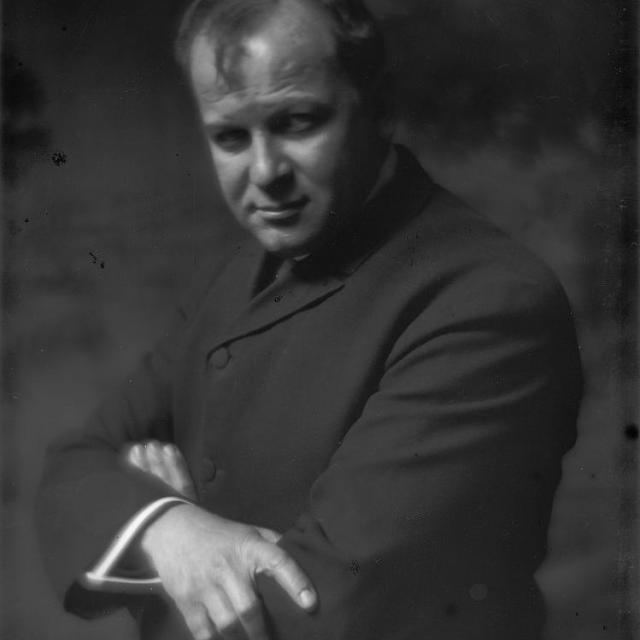
George Luks
American, 1866 - 1933
George Luks was born in Williamsport, Pennsylvania, in 1866 to a lively and cultured family. Luks’s father, a multilingual doctor, emigrated from Poland; Luks’s mother, born to a noble family in Germany, was an amateur painter. At a young age, Luks moved with his family to the coal-mining town of Shenandoah, Pennsylvania. He studied briefly at the Pennsylvania Academy of the Fine Arts in 1884 and spent several years as a traveling vaudeville performer with his brother Will.
In 1889 Luks embarked on his first trip to Europe. He attended the Academy of Fine Arts in Düsseldorf for a few months and visited major museum collections in Paris and London. A second voyage to Europe a few years later took Luks to Spain, where he drew inspiration from the works of Diego Velázquez (Spanish, 1599–1660) and Francisco de Goya (Spanish, 1746–1828). He also made several trips to Paris in the early 1900s. As his career progressed, Luks did not draw attention to his privileged upbringing or to his European travels as a young man. Instead, Luks became known as a boastful, quarrelsome alcoholic who gave distorted accounts of his past—emphasizing youthful exploits and the bucking of tradition, even inventing an alter ego, the boxer “Chicago Whitey.”
In the early 1890s, Luks worked in Philadelphia as a magazine and newspaper illustrator. There he joined the circle of young artists who had gathered around Robert Henri (American, 1865–1929), including fellow newspaper illustrators William Glackens (American, 1870–1938), Everett Shinn (American, 1876–1953), and John Sloan (American, 1871–1951). In 1895 Luks traveled to Havana as an artist-correspondent for the Philadelphia Bulletin, where he covered the Cuban fight for independence from Spanish rule. Upon his return to the United States, Luks started work at the New York World and drew the cartoon Hogan’s Alley featuring the Yellow Kid, which had been originated by Richard Outcault (1863–1928).
Though Luks continued to work as an illustrator, his paintings began to achieve recognition at the turn of the century. In 1903 Luks exhibited with the Society of American Artists, and in 1908 he participated in the show of The Eight at the Macbeth Gallery. The artists shown at Macbeth, along with George Bellows and several others, were later dubbed the Ashcan school for their focus on the grittier side of modern New York. Luks’s paintings represent life on Manhattan’s Lower East Side, and his portraits of children, beggars, and unusual individuals express a marked concern for the plight of these figures. He painted in a dark palette and with a vigorous handling of paint that reflected the influence of Frans Hals (Dutch, c. 1581–1666), whose works Luks had seen on his travels.
Two years after The Eight exhibition, Luks had his first solo show at Macbeth. A member of the Association of American Painters and Sculptors, Luks was included in the Armory Show of 1913. The following year he began to submit illustrations to Vanity Fair, the beginning of a publishing relationship that lasted the remainder of his life. Luks was represented by the Kraushaar Galleries until 1925, when he switched to the Frank K. M. Rehn Galleries. By then Luks had established himself as a prolific, well-known artist; he exhibited widely and received awards, including the gold medal at the Corcoran Gallery of Art’s biennial exhibition in 1932. He taught at the Art Students League between 1920 and 1924 and later opened the George Luks School of Painting in New York. However, he was never able to extricate himself from his identity as a brawler. In 1933 Luks was found dead in a lower Manhattan doorway under mysterious circumstances, possibly the result of injuries from a bar fight.
Explore Selected Works
Artwork

Self-Portrait: Interior of My New York Apartment
Self-Portrait: Interior of My New York Apartment
George Luks · 1927 · watercolor over graphite on wove paper mounted to board · Accession ID 2015.19.2786
Artwork

Artwork

Four Figures
Four Figures
George Luks, Bea Evan · c. 1925 · black crayon and graphite on wove paper · Accession ID 2015.19.1065
Artwork

The Man with the Red Bible
The Man with the Red Bible
George Luks · 1919 · watercolor and graphite on wove paper · Accession ID 2015.19.2904
Artwork

Artwork

Woman in Doorway
Woman in Doorway
George Luks · 1900-1930 · watercolor on wove paper · Accession ID 2015.19.3389
Artwork

Lady Seated and Smoking at a Table
Lady Seated and Smoking at a Table
George Luks · · black colored pencil over graphite · Accession ID 2024.158.3
Artwork

Bibliography
1931
Cary, Elizabeth L. George Luks. New York, 1931.
1987
Cuba, Stanley L.., Nina Kasanof, and Judith H. O’Toole, George Luks : an American artist. Wilkes-Barre, PA, 1987.
2009
Gambone, Robert L. Life on the Press: The Popular Art and Illustrations of George Benjamin Luks. University Press of Mississippi, 2009. JSTOR, www.jstor.org/stable/j.ctt2tvbcv.




